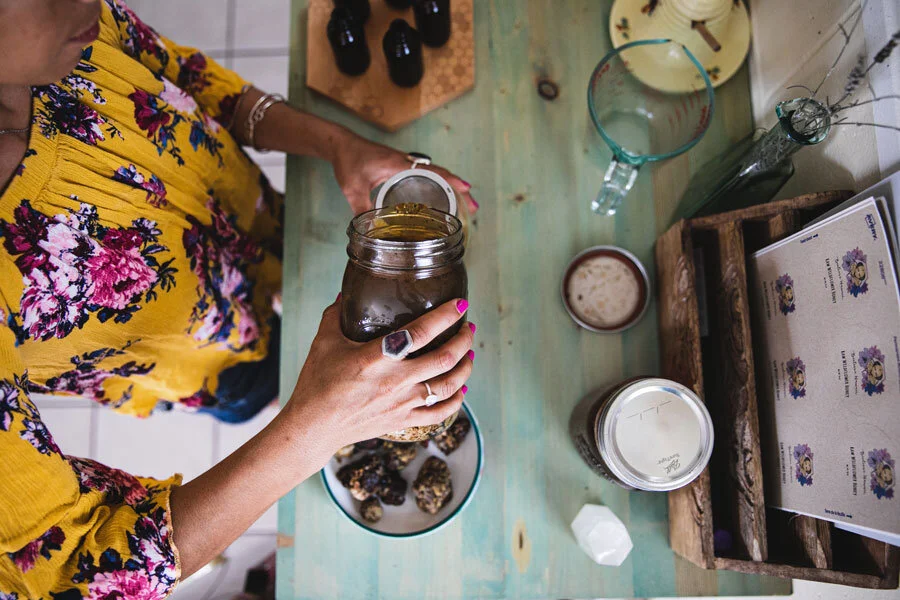Poetry In Pollination: How Jasmine Joy Mentors About Ethical Beekeeping
Original post at teva.com
Meet Jasmine Joy, an educator and beekeeper in Honolulu, Oahu who connects with her ecosystem through making friends with pollinators and crafting healing tinctures. Words and Photos by Gretchen Powers.
When I first discovered Jasmine Joy, I was four months into living on a new island (Oahu). Having recently moved from another very different island (Kodiak, AK), I was craving connection with a fellow waterperson and maker—in her case, surfing and making healing tinctures and in mine, canoeing and creating photos, knitted headwear, and jewelry.
Our Instagram DMs and comments flourished into a real life friendship as we bonded over our passions. Jasmine’s energy radiates when she is tending to her beehives or encountering them in the wild—a species she has an innate curiosity and kinship with. I spent a few days with Jasmine in her element, learning about threatened bees, the tinctures she creates from them and why Hawaii is her chosen home.
Tell us about your background. How did you end up in Hawaii?
JASMINE JOY: Both of my parents come from third world countries that were colonized by the Spanish in the 16th century. My mother was born in the Philippines and my father’s birthplace is Nicaragua. They immigrated with their families to Los Angeles, CA, where I was born. My upbringing was far from a common American girl’s lifestyle since I was raised by two Filipino generations and able to speak our native language called, Kapampangan.
I moved to Honolulu, HI in 2006 to further my education in Business at the University of Hawaii and immerse myself in a culture that felt very similar to my mother’s lineage. Filipinos have been a part of Hawaii’s melting pot since old plantation days of farming sugar in the early 1900s. I feel embraced as a female entrepreneur of mixed Filipino ancestry because my people are respected for their work ethics in Hawaii.
Jasmine wears the HURRICANE XLT2 sandals in Vista Sunset featuring 100% recycled straps made from discarded plastic water bottles
How did you get interested in beekeeping and why do you love it?
JASMINE: I started working for an organic skincare company called, Honey Girl Organics, in 2011. My best friend and I used to manage the creamery department and concoct all their body products from face to feet. We would harvest honey, beeswax, and propolis (a waxy mixture produced from tree resin and sap collected by bees) from their hives and mix them mainly with olive oil and essential oils.
The founder of Honey Girl Organics naturally became my beekeeping guru. The first colony I kept was rescued by him and I on the North Shore of Oahu. I love being a bee guardian because I’m able to serve my communities by caring for a threatened species that is crucial to our sustainable food systems.
The Kaiwi Scenic Shoreline in Honolulu is home to the Hawaiian Yellow-Faced Bee, a species under the threat of invasive species and habitat loss. Jasmine was part of a team that monitored the bees on this protected site.
Could you describe what beekeeping entails and what a typical day looks like for you?
JASMINE: The role of an apiarist is truly a labor of love. I do not feel separate from the species, Apis mellifera, which means I am literally, “busy as a bee.” I tend to 40 hives between two farms that require inspection every couple of weeks. By having each colony on a regular schedule of maintenance, my team and I are able to track pests like Varroa mites and mitigate their populations.
Varroa mites are tiny parasites that weaken honeybee colonies and pass on a pathogen called Deformed wing virus. As a treatment-free beekeeper, I do not use chemicals to control mites. Instead, I introduce a method of Integrated Pest Management called sugar dusting. I sift organic powdered sugar all over the bees and their honeycomb with brood (bee babies) so they clean it off of each other and adapt the behavior of being more hygienic. The bees end up plucking mites off of one another.
When I am not tending to my own hives, I participate in live bee removal with an ethos of “rescue, relocate, rehabilitate, educate” and am passionate about changing the dialogue from “pest control” to “bee rescue” by valuing pollinators and their vital role in a sustainable food system.
Jasmine lightly puffs smoke at the entrances of her hives to let the bees know it’s time for inspections. Since bees communicate by releasing different pheromone scents, the smoker is used to keep their temperament calm.
What is ethical beekeeping? Why is it important?
JASMINE: When people find out I’m a beekeeper, the most common question that follows is: “So you make honey?” I always reply, “Well, my bees do the hard work and I just process their extra supply.”
Taking credit for their proficiency of alchemizing nectar isn’t fair in my perspective. Unlike most beekeepers, honey production is not my primary focus. I ethically harvest from hives with 2+ boxes to ensure that each colony has enough food storage for rainy days in Hawaii. I talk to my bees and let them know when it’s time to pay a little rent in liquid gold. The surplus I collect from them is considered boutique honey and is sold to exclusive clientele. Ethical beekeeping embraces a holistic and chemical-free approach to supporting the wellness of bees and their habitats.
In good company: the HURRICANE XLT2 sandals in Vista Sunset and GRANDVIEW GTX waterproof hiking boots go from a muddy hike to garden chores with ease.
Tell us about your business, Beelieve Hawaii.
JASMINE: Beelieve Hawaii is the name of my business that covers everything I do from bee rescue, mentorship, farm tours to the products I hand craft from my hives. My flagship product, Propolis Tincture, is made from the raw resin I harvest ethically. Propolis is resin that trees emit to heal itself like sap. It is anti-microbial, anti-fungal, and anti-bacterial. Every time I do colony inspections I have to remove the propolis seal that the bees create under the cover of each beehive. I am able to transfer this medicine into a vodka-based tincture that is sweetened with honey so humans can enjoy these healing benefits. It’s great internally as an immunity booster or for sore throats and can be used topically to treat wounds or scrapes.
How does beekeeping make you feel more connected to your environment?
JASMINE: Being a guardian of bees means I’m caring for essential insects that can pollinate flora in a five mile radius from their hives. These remarkable creatures know when a flower is at its most nourishing state and will wait for that moment to forage from it. A honeybee visits 50 to 100 flowers during a collection trip and it takes two million flowers to make a pound of beeswax.
In the spring and summer when the nectar is flowing, a honeybee’s lifetime only lasts four to six weeks. The average female worker bee will make seven drops of honey in that short cycle which is 1/12th of a teaspoon. On top of being the only insect that produces food eaten by humans, they are pollinating fruit trees and vegetable crops in their vicinity. They are solar-powered little poets that hum verses from the wild with the buzzing of their wings.
Beekeeping has taught me more about my environment than any teacher in a classroom. Whenever I am present with the honeybees, I am able to receive messages from the tips of the trees to the minerals of the earth around me.
All of Beelieve Hawaii’s products are made by hand in small batches.
Tell us about some of your favorite ways to be outside in Hawaii!
JASMINE: Surfing, skimboarding, hiking, or practicing qigong in the park are some of my favorite ways to be outside when I’m not at a farm. Exploring nature’s various ecosystems, from the mountains to the ocean, is one way I perpetuate adventure and balance in my busy life. Since the Hurricane XLT2 is an all-terrain sandal, its versatile design can be worn on a muddy trail or a sandy beach to fit my paradise lifestyle.
Tell us about a time where you felt In Your Element at home in Hawaii and why.
JASMINE: I always feel most in my element when my fiery personality is close to the water or in the ocean which balances my constitution. I was recently part of a project called “Pollinators in Paradise” and would monitor the Hawaiian yellow-faced bee’s (Hylaeus) protected site along the Kaiwi Shoreline. The Hawaiian yellow-faced bee is one of the first bees on the endangered species list and is still under the threat of invasive species and habitat loss. Getting to work on projects like this and being one with Mother Nature is where my purpose to support the biodiversity of animal species from humans to insects feels fulfilled.














